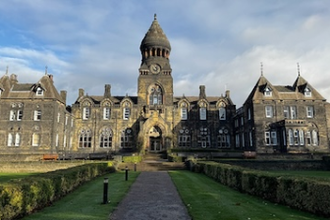Rome: The Church Up Close - Day 6

1930s Vatican telescope
Did you know that on the day of the first moon landing in 1969, Pope Paul VI looked at the moon through a telescope at the Vatican Observatory? Our group of Catholic journalists saw a photo of this today in the observatory at Castel Gandolfo.
The Vatican Observatory is one of the oldest astronomical institutes in the world, dating from the sixteenth century. Partly in order to counteract longstanding accusations of a hostility of the Church towards science, Pope Leo XIII in 1891 formally re-founded the Observatory and located it on a hillside behind the dome of St Peter's Basilica. For four decades astronomical research was carried out in the shadow of St Peter's, but the sky above Rome became too bright to study the stars. Thus, in the 1930s, it was moved to the Papal Summer Residence at Castel Gandolfo in the Alban Hills some 20 miles southeast of Rome. It was entrusted to the Jesuits. And since 1981 there has been a second research center in Tucson, Arizona in the United States, one of the world's largest and most modern centres for observational astronomy.
At Castel Gandolfo we climbed to the roof, to a terrace commanding a beautiful view over Lake Albano and noticed a plaque on the wall, 'Deum Creatorem Venite Adoremus' or 'O come let us adore God the Creator'. We were shown into a room next to the telescopes and heard Prof Paul Mueller SJ, specialist in History and Philosophy of Science, talk about 'The Catholic Church and Scientific Culture'. Alongside him was Prof Richard A D'Souza SJ, an astronomer researching Galaxy Formation and Evolution and Prof Robert Mackie SJ, Curator of the Meteorite Collection. They honestly answered all our questions, even though most of us did not have the background to fully understand their work, and showed us the telescopes.
Why does the Vatican have an observatory? Aren't there more important things to do than look at the stars? It was suggested to us that humanity's constant fascination with astronomy and the heavens across the ages reveals to us our own search for transcendence, and how the study of the cosmos can be an act of worship. The wonders of the universe show the great diversity, love and beauty of God the creator. The Jesuit astronomers believe that people of faith can also believe in science, and we picked up that all three scientists were fascinated by the mysteries of the universe and of God. God can be found in all things. They reported they are frequently asked about cosmological dimensions of the story of Jesus, particularly the Star of Bethlehem. It was another Jesuit, Fr Teilhard de Chardin, who explored the relationship between Christ and the Universe more than 60 years ago, and the Jesuit Pope Francis who produced the Church's first environment encyclical.
Back on the terrace we contemplated as people of faith the beauty and mystery of the volcanic crater lake below and the cloudless blue sky above. We felt a cooling breeze, recalling that the Holy Spirit is often described as a gentle wind.
Transcendence was a theme in our visit to the Vatican museums. The Missionaries of Divine Revelation are the official guides for the Vatican Museums, and one of their sisters delivered a tour interweaving Christianity and culture, faith and art. It was a tour after dusk and the sight of St Peter's dome silhouetted against the setting sun gave us a sense of awe before setting off. We visited just some of the 54 galleries, with the Sistine Chapel being the last stop within the Museum. The great frescoes by Michelangelo were completed in the early sixteenth century, and the highlight of the evening for us was simply joining the hundreds of people praying or quietly reflecting in the Sistine Chapel - it was nearly 11pm, but we didn't want to go home.


















